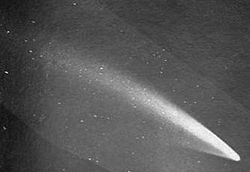 The Great January Comet of 1910, formally designated C/1910 A1 and often referred to as the Daylight Comet[ appeared in January 1910. It was already visible to the naked eye when it was first noticed, and many people independently "discovered" the comet. At its brightest, it outshone the planet Venus, and was possibly the brightest comet of the 20th century.
The Great January Comet of 1910, formally designated C/1910 A1 and often referred to as the Daylight Comet[ appeared in January 1910. It was already visible to the naked eye when it was first noticed, and many people independently "discovered" the comet. At its brightest, it outshone the planet Venus, and was possibly the brightest comet of the 20th century.
The comet brightened rather suddenly, and was initially visible from the southern hemisphere only. A number of individuals claimed "discovery", but the comet is thought to have been first spotted by diamond miners in the Transvaal before dawn on January 12, 1910, by which time it was already a prominent naked-eye object of apparent magnitude −1.
The first person to study the comet properly was Scottish astronomer Robert T. A. Innes at the Transvaal Observatory in Johannesburg on January 17, after having been alerted two days earlier by the editor of a Johannesburg newspaper.
The comet reached perihelion (the point in the orbit of a planet, asteroid or comet where[& when] it is nearest to the sun. on January 17 and was at that time visible in daylight with the unaided eye; following perihelion, it declined in brightness but became a spectacular sight from the northern hemisphere in the evening twilight, its noticeably curved tail reaching up to 50 degrees by early February.
